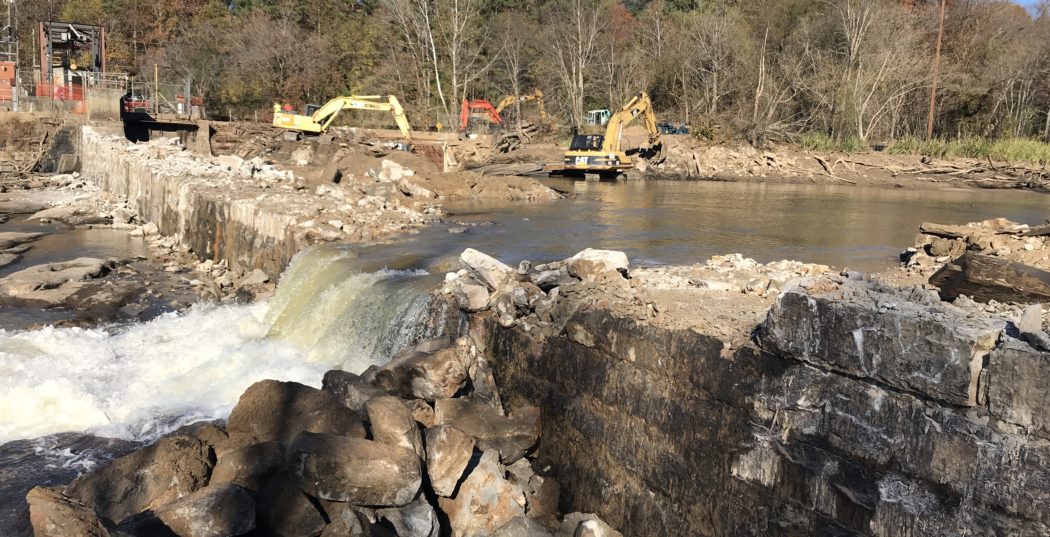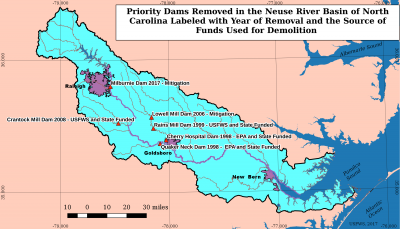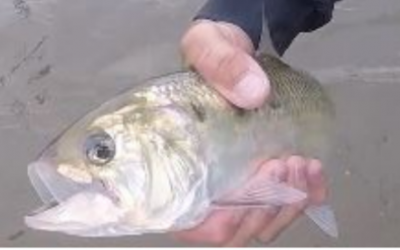River Advocates Celebrate Dam Removal
PDF version: River Advocates Celebrate Dam Removal_Coastal Review Online
Original source link: https://www.coastalreview.org/2018/05/river-advocates-celebrate-dam-removal/
Time-lapse video shows the removal of Milburnie Dam on the Neuse River in Raleigh by Restoration Systems during a four-month span in late 2017-18. The removal revealed rapids, which river advocates have dubbed Milburnie Falls. Video: Restoration Systems
RALEIGH – The Neuse River is flowing more naturally now, with its waters and its migratory fish moving in ways not seen in centuries.
That’s since the long-planned removal late last year of the decrepit and dangerous Millburnie Dam, which stood a few miles away from the capital city’s downtown. But the company behind the work says the dam wasn’t simply demolished, it was replaced by a habitat-restoration project known as a mitigation bank.
Advocates say the removal is already bringing ecological benefits to the entire river, which winds from the Piedmont to Pamlico Sound. Milburnie was the last of several dams on the Neuse that impeded migratory fish from the coast and it was since 2001 ranked among state and federal agencies’ top 10 of 5,000 dams statewide as a priority for removal.
“We’ve been working to remove that dam for a number of years now and it’s a tremendous positive thing for the river,” said Upper Neuse Riverkeeper Matthew Starr of the Sound Rivers organization. “Obviously, returning a river to its natural, free-flowing system is a benefit to the entire river.”
Starr said the removal means anadromous fish such as striped bass, American shad and Atlantic sturgeon can now swim to their native spawning grounds upriver of the dam site.
One of the first studies by the organization now known as the Albemarle-Pamlico National Estuary Partnership concluded in 1989 that dams on rivers in North Carolina’s coastal plain were a big factor in the declining population of once-thriving regional fisheries. The removal more than 20 years ago of the Quaker Neck Dam near Goldsboro re-opened about 80 miles of the Neuse and more than 920 miles of streams as spawning habitat and was one of the first such projects nationwide undertaken for ecological reasons. The subsequent removal of the nearby Cherry Hospital dam on the Little River restored another 76 miles of streams for anadromous fish habitat in the Neuse River basin.
That’s since the long-planned removal late last year of the decrepit and dangerous Millburnie Dam, which stood a few miles away from the capital city’s downtown. But the company behind the work says the dam wasn’t simply demolished, it was replaced by a habitat-restoration project known as a mitigation bank.
Advocates say the removal is already bringing ecological benefits to the entire river, which winds from the Piedmont to Pamlico Sound. Milburnie was the last of several dams on the Neuse that impeded migratory fish from the coast and it was since 2001 ranked among state and federal agencies’ top 10 of 5,000 dams statewide as a priority for removal.
“We’ve been working to remove that dam for a number of years now and it’s a tremendous positive thing for the river,” said Upper Neuse Riverkeeper Matthew Starr of the Sound Rivers organization. “Obviously, returning a river to its natural, free-flowing system is a benefit to the entire river.”
Starr said the removal means anadromous fish such as striped bass, American shad and Atlantic sturgeon can now swim to their native spawning grounds upriver of the dam site.
One of the first studies by the organization now known as the Albemarle-Pamlico National Estuary Partnership concluded in 1989 that dams on rivers in North Carolina’s coastal plain were a big factor in the declining population of once-thriving regional fisheries. The removal more than 20 years ago of the Quaker Neck Dam near Goldsboro re-opened about 80 miles of the Neuse and more than 920 miles of streams as spawning habitat and was one of the first such projects nationwide undertaken for ecological reasons. The subsequent removal of the nearby Cherry Hospital dam on the Little River restored another 76 miles of streams for anadromous fish habitat in the Neuse River basin.
Another important benefit is improved water quality, Starr said.
“It already has done wonders – a river’s not meant to be impounded,” Starr said. “It’s an ecosystem approach. It may seem pinpoint, but (removing the dam) contributes to the overall health of the river. And most importantly, it has to do with safety. There have been a number of drownings and this removes that threat.”
Those deaths, blamed on the deceptively powerful hydraulic turbulence that the dam created, along with other potential liabilities and concerns related to the deteriorating powerhouse that hadn’t generated electricity in more than a decade, had prompted the property owners to seek its removal.
The owners, the family of the late Howard Twiggs, a Raleigh attorney, contracted with Restorations Systems LLC of Raleigh, an environmental restoration and mitigation company, for the removal and mitigation project.
“The owners wanted it removed – it was their father’s wish,” said Tiffani Bylow, the project’s manager at Restoration Systems. “After he passed away, his daughters and his sister saw that through.”
Removing the dam opened about 15 miles of river to spawning migratory fish, such as American and hickory shad and striped bass.
“It’s already showing huge success at this point,” Bylow said. She noted several catches of American shad have been documented upriver at the tailrace of the Falls Lake Dam since late April.
That’s cause for celebration. Restoration Systems, Sound Rivers and the national conservation nonprofit American Rivers are joining to host this Saturday the Raleigh River Fest. The organizers hope the planned paddle race, fish fry, fishing rodeo and other festivities at the former dam site now dubbed Milburnie Falls will become an annual event.
River Banks, Mitigation Banking
Planning for the removal project took about 10 years. Because of limited state and federal funds, Restoration Systems determined that the best way to pay for removing the dam – a project that would cost millions of dollars – was to use a provision of Section 404 of the Clean Water Act called mitigation banking. Setting up that banking instrument took a big chunk of the prep time.
The federal regulatory program allows for projects to remove river and stream barriers to generate stream restoration credits. Those credits can then be used to meet the compensatory mitigation – the restoration, creation, enhancement or preservation of natural resources – required for projects that damage the environment.
Permitting the project as a mitigation bank allows for the sale of mitigation credits to offset damage done to other waterways in the region. It’s also a tool that could be used to remove other obsolete dams across the country where funding is an obstacle.
Under Section 404, the Army Corps of Engineers, before issuing a permit, must work with the project’s proponent to first avoid and minimize adverse effects and then to provide compensation for damage that’s unavoidable. The Corps’ regulatory program is based on a policy goal of no net loss of wetlands and there’s no exclusion for manmade wetlands, such as those created by a dam, said Jean Gibby, chief of the Army Corps of Engineers’ Raleigh field office.
“Restoration Systems is generating mitigation credits for impacts to streams,” Gibby explained.
The total number of credits, called stream mitigation units or SMUs, awarded to the bank is determined based on standards detailed in the mitigation plan. If all performance standards are met, the bank will be awarded its maximum credit potential. In North Carolina, the Department of Environmental Quality’s Division of Mitigation Services, or DMS, works with companies that set up mitigation banks in the state by selling program credits.
“In 2008, a mitigation rule came out from the Corps and it stated that if you’re going to do a mitigation bank this is how you have to do it,” Gibby explained.
Also that year, the Corps and other agencies issued a rule for dam removal projects in North Carolina. “The documents came out together,” Gibby said. Until that time, there was no set procedure to identify when and how dam removal should be used as compensatory mitigation for loss of streams and stream functions from development projects.
“This mitigation guidance was the first of its kind in the country. We had to think outside the box,” Gibby said. “It couldn’t have happened if we didn’t have this guidance.”
For this project, SMUs are awarded for factors such as creating an appropriate aquatic community that includes mussels, fishes and aquatic insects; habitat restoration for rare, threatened or endangered species; observation of American shad, including their passage upstream of the dam; and scientific research completed and published in peer-reviewed journals.
Gibby said re-establishing some of the appropriate aquatic species will take some time.
“Bugs that indicate a flowing river were not there, but they will come back,” she said. “Critters that live in a lake don’t live in a flowing river.”
The change will also likely bring the demise of some species, but others may adapt, she said.
Regarding the restoration of endangered species, “in this case we’re looking at mussel species,” Gibby said, referring specifically to the dwarf wedgemussel. “If we can prevent a state-listed species from becoming a federal species through habitat restoration, we give credit for that.”
The mussels in question will take three to four years before it’s appropriate to survey for them. “They may already be there, but it’s too detrimental to do survey to find them,” Gibby explained.
Another mussel, the yellow lance, wasn’t a listed species prior to the project but was listed as threatened in 2017 after surveys showed the species had lost 57 percent of its historical range.
But in the case of Milburnie, Gibby said, anadromous fish – “That was the big thing.”
Why are anadromous fish so important? Gibby said shad is a vital fishery resource from a commercial standpoint. Like salmon, they spawn in the rivers they were born in.
Starr, the Riverkeeper, said some anadromous species, such as shad, were faring relatively well, but not striped bass. “Striper is a whole different ball game. The striper fishery long ago was not quite as prolific as shad but the river used to have a significant striper population,” he said.
Also, to satisfy state regulators, wetlands restoration must be at least equal to the damage it offsets. In other words, for every foot of damage, at least one foot of mitigation must be in the form of restoration.
Gibby said that in the case of Milburnie Dam, there were initial concerns regarding wetlands immediately upstream of the structure.
“Mr. Twiggs, who’s now deceased, was very environmentally conscious, he wanted it gone,” Gibby said. “This was a dream of the family to ultimately get the dam removed but you would have to address wetlands drainage no matter what or who removed it. We were looking at up to 15 acres of wetlands that could be impacted.”
Some of this change would affect nearby property owners, folks who’d built homes and docks on the lake-like area upstream of the dam. Many responded when the 30-day public notice for the project was issued.
“There was a public backlash,” Gibby said. “Everybody came out of the woodwork that didn’t want the pond gone.”
The first American shad at the tailrace of the Falls Lake Dam on the
Neuse River was caught April 25 by E.J. Stern. Photo: Restoration Systems
Gibby said there was nothing in the comments that would have resulted in the denial of the project. “They have to have some pretty good reasons to deny the permit.”
Also, the opposition came from what Gibby described as a vocal few. One of the early opponents owned a pontoon boat that would be left high and dry by the dam removal. The owner eventually had a change of heart and Restoration Systems purchased his boat and donated it to the Sound Rivers organization.
According to a history of the dam provided by Sound Rivers, the Milburnie Dam dates to the 1700s when the earliest known river barrier at the site was used to power a grist mill. Later, in the 1850s, the site was home to a paper mill that Union troops destroyed in 1865. A sawmill operated at the location until 1880. About 20 years later, the Raleigh Ice & Electric Co. built a stone dam at the site that was later purchased by Carolina Power and Light. The property has been in the Twiggs family since 1934, which leased the site in the late 1970s to a Pennsylvania company that built a new hydroelectric plant that operated from 1984 until sometime between 2006 and 2009. Since then, the structure had fallen into disrepair, becoming what many described as a dangerous eyesore.
Restoration Systems began draining the 6-mile impoundment behind the dam last September. The dam removal happened in November. Starr said the it was a big step toward improving the Neuse River’s overall health.
“We’re a long way from having a truly healthy river but we’ve made a lot of progress from where we were in the ’90s,” Starr said. “There are many, many pollution threats, however, we’ve done a good job as a river basin to remove some of those threats and make some threats less. But the emerging contaminants issue is an example of how we can remove one threat, but we still have to deal with another. There’s still a tremendous amount of work to do.”







